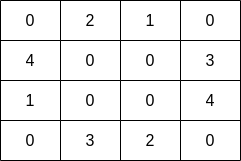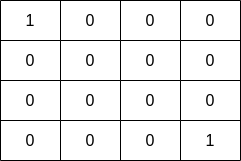2658. Maximum Number of Fish in a Grid
2658. Maximum Number of Fish in a Grid
Description
You are given a 0-indexed 2D matrix grid of size m x n, where (r, c) represents:
- A land cell if
grid[r][c] = 0, or - A water cell containing
grid[r][c]fish, ifgrid[r][c] > 0.
A fisher can start at any water cell (r, c) and can do the following operations any number of times:
- Catch all the fish at cell
(r, c), or - Move to any adjacent water cell.
Return the maximum number of fish the fisher can catch if he chooses his starting cell optimally, or 0 if no water cell exists.
An adjacent cell of the cell (r, c), is one of the cells (r, c + 1), (r, c - 1), (r + 1, c) or (r - 1, c) if it exists.
Example 1:

1 | Input: grid = [[0,2,1,0],[4,0,0,3],[1,0,0,4],[0,3,2,0]] |
Example 2:

1 | Input: grid = [[1,0,0,0],[0,0,0,0],[0,0,0,0],[0,0,0,1]] |
Constraints:
m == grid.lengthn == grid[i].length1 <= m, n <= 100 <= grid[i][j] <= 10
Hints/Notes
- 2025/03/02 Q2
- dfs
- 0x3F’s solution
Solution
Language: C++
1 | class Solution { |